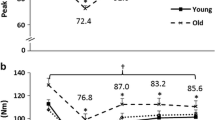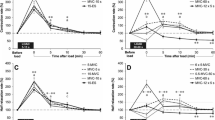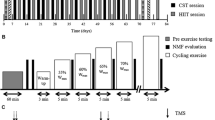Summary
The 24 h recovery pattern of contractile properties of the triceps surae muscle, following a period of muscle fatigue, was compared in physically active young (25 years,n = 10) and elderly (66 years,n = 7) men. The fatigue test protocol consisted of 10 min of intermittent submaximal 20 Hz tetani. The maximal twitch (p t) and tetanic force at 3 frequencies (10, 20 and 50 Hz) were determined at baseline and at 15 min, 1, 4 and 24 h after fatiguing the muscle. Maximal voluntary contraction (MVC) and vertical jump (MVJ) were also assessed. The loss of force during the fatigue test was not significantly different between the young (18±13%) and elderly (22±15%). Both groups showed similar and significant reductions of Pt (15%), tetanic force (10 to 35%) and rate of force development (dp/dt) (20%) 15 min and 1 h into recovery. The loss of force was greater at the lower stimulation frequencies of 10 and 20 Hz. Time-to-peak tension was unchanged from baseline during recovery in either group. The average rate of relaxation of twitch force (−dPt/dt) was decreased (p<0.05) and half-relaxation time significantly increased at 15 min and 1 h in the elderly but not the young. The findings indicate that after fatiguing contractions, elderly muscle demonstrates a slower return to resting levels of the rate and time course of twitch relaxation compared to the young.
Similar content being viewed by others
References
Aniansson A, Grimby G, Hedberg M, Rundgren A, Sperling L (1978) Muscle function in old age. Scan J Rehab Med [Suppl] 6:43–49
Aniansson A, Grimby G, Nygaard E, Saltin B (1980) Muscle fiber composition and muscle fiber area in various age groups. Muscle Nerve 2:271–272
Bellemare F, Woods JJ, Johansson R, Bigland-Ritchie B (1983) Motor-unit discharge rates in maximal voluntary contractions of three human muscles. J Neurophysiol 50:1380–1392
Bigland-Ritchie B, Jones DA, Woods JJ (1979) Excitation frequency and muscle fatigue: electrical responses during human voluntary and stimulated contractions. Exp Neurol 64:414–427
Costill DL, Fink WJ, Pollock ML (1976) Muscle fiber composition and enzyme activities of elite distance runners. Med Sci Sports 8:96–100
Cunningham DA, Rechnitzer PA, Howard JH, Donner AP (1987) Exercise training of men at retirement: clinical trial. J Gerontol 42:17–23
Davies CTM, White MJ (1981) Muscle weakness following eccentric work in man. Pflügers Arch 392:168–171
Davies CTM, White MJ (1982) Muscle weakness following dynamic exercise in humans. J Appl Physiol 53:236–241
Davies CTM, White MJ (1983a) Contractile properties of the elderly human triceps surae. Gerontol 29:19–25
Davies CTM, White MJ (1983b) Effects of dynamic exercise on muscle function in elderly men, aged 70 years. Gerontol 29:26–31
Davies CTM, Young K (1985) Muscle weakness following sustained and rhythmic isometric contractions in man. Eur J Appl Physiol 54:301–305
Davies CTM, Mecrow IK, White MJ (1982) Contractile properties of the human triceps surae with some observations on the effects of temperature and exercise. Eur J Appl Physiol 49:255–269
Dawson MJ, Gadian DG, Wilkie DR (1980) Mechanical relaxation rate and metabolism studied in fatiguing muscle by phosphorus nuclear magnetic resonance. J Physiol 299:465–484
Dixon WJ, Massey FJ (1957) Introduction to statistical analysis, New York, McGraw-Hill
Edwards RHT, Hill DK, Jones DA (1975) Metabolic changes associated with the slowing of relaxation in fatigued mouse muscle. J Physiol 251:287–301
Edwards RHT, Hill DK, Jones DA, Merton PA (1977) Fatigue of long duration in human skeletal muscle after exercise. J Physiol 272:769–778
Ermini M, Szelenyi I, Moser P, Verzar F (1971) The ageing of skeletal (striated) muscle by changes of recovery metabolism. Gerontologia 17:300–311
Fitts RH, Troup JP, Witzmann FA, Holloszy JO (1984) The effect of ageing and exercise on skeletal muscle function. Mech Ageing Devel 27:161–172
Grabowski W, Lobsiger EA, Luttgau HCH (1972) The effect of repetitive stimulation at low frequencies upon the electrical and mechanical activity of single muscle fibers. Pflügers Arch 334:222–239
Hermansen L (1981) Effect of metabolic changes on force generation in skeletal muscle during maximal exercise. In: Porter R, Whelan J (eds) Human muscle fatigue: physiological mechanisms. Ciba Foundation symposium 82. Pitman Medical, London, pp 75–88
Hultman E, Sjoholm H, Sahlin K, Edstrom L (1981) Glycolytic and oxidative energy metabolism and contraction characteristics of intact human muscle. In: Porter R, Whelan J (eds) Human muscle fatigue: physiological mechanisms. Ciba Foundation Symposium 82. Pitman Medical, London, pp 19–40
Jennekens FGI, Tomlinson BE, Walton JN (1971) Histochemical aspects of five limb muscles in old age. An autopsy study. J Neurol Sci 14:259–276
Jones DA (1981) Muscle fatigue due to changes beyond the neuromuscular junction. In: Porter R, Whelan J (eds) Human muscle fatigue: physiological mechanisms. Ciba Foundation Symposium 82. Pitman Medical, London, pp 178–196
Jones PRM, Pearson J (1969) Anthropometric determination of leg fat and muscle plus bone volumes in young male and female adults. J Physiol 204:63p-66p
Larsson L, Karlsson J (1978) Isometric and dynamic endurance as a function of age and skeletal muscle characteristics. Acta Physiol Scand 104:129–136
Larsson L, Sjodin B, Karlsson J (1978) Histochemical and biochemical changes in human skeletal muscle with age in sedentary males, age 22–65 years. Acta Physiol Scand 103:31–39
Lexell J, Henriksson-Larsen K, Winblad B, Sjostrom M (1983) Distribution of different fiber types in human skeletal muscles: effects of aging studied in whole muscle cross sections. Muscle Nerve 6:588–595
Lind AR, Petrofsky JS (1978) Isometric tension from rotary stimulation of fast and slow cat muscles. Muscle Nerve 1:213–218
McDonagh MJN, White MJ, Davies CTM (1984) Different effects of aging on the mechanical properties of human arm and leg muscles. Gerontol 30:49–54
McNamara MC, Miller AT jr, Shen AL, Wood JJ (1978) Restitution of ATP and creatine phosphate after experimental depletion in young, adult, and old rats. Gerontol 24:95–103
Moritani T, Muro M, Kijima A (1985) Electromechanical changes during electrically induced and maximal voluntary contractions: Electrophysiologic responses of different muscle fiber types during stimulated contractions. Exper Neurol 88:471–483
Newton JP, Yemm R (1986) Changes in the contractile properties of the human first dorsal interosseous muscle with age. Gerontol 32:98–104
Patrick JM, Bassey EJ, Fentem PH (1983) The rising ventilatory cost of bicycle exercise in the seventh decade: a longitudinal study of nine healthy men. Clin Sci 65:521–526
Richardson D, Shewchuk R (1980) Comparison of calf muscle blood flow responses to rhythmic exercise between mean age 25- and 74-year-old men. Proc Soc Exper Biol 164:550–555
Taylor DJ, Crowe M, Bore PJ, Styles P, Arnold DL, Radda GK (1984) Examination of the energetics of aging skeletal muscle using nuclear magnetic resonance. Gerontol 30:2–7
Vandervoort AA, McComas AJ (1986) Contractile changes in opposing muscles of the human ankle joint with aging. J Appl Physiol 61:361–367
Winer BJ (1971) Statistical principles in experimental design, 2nd ed, New York, McGraw-Hill, p 796
Author information
Authors and Affiliations
Rights and permissions
About this article
Cite this article
Klein, C., Cunningham, D.A., Paterson, D.H. et al. Fatigue and recovery contractile properties of young and elderly men. Europ. J. Appl. Physiol. 57, 684–690 (1988). https://doi.org/10.1007/BF01075989
Accepted:
Issue Date:
DOI: https://doi.org/10.1007/BF01075989




